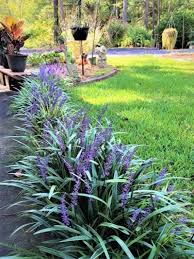A grass border is a lovely addition to any garden or outdoor space. It adds a touch of natural beauty and can enhance the overall appearance of your surroundings. Creating a grass border is a simple yet effective way to define different areas of your garden, add a sense of organization, and infuse a sense of tranquility.
To start, you’ll need to choose the right type of grass for your border. There are various options available, such as ornamental grasses, which are known for their graceful movements in the wind, or low-growing grasses that create a soft and lush carpet-like effect. Consider the climate and soil conditions in your area to select the grass that will thrive the best.
Once you’ve selected the grass, it’s time to prepare the area where you want to create the border. Clear the space of any weeds, rocks, or debris. You can use a shovel or a spade to dig a shallow trench along the edge of the designated area. The trench will help to contain the grass and prevent it from spreading into other parts of your garden.
Next, you’ll need to add soil to the trench. Choose a well-draining soil that is rich in nutrients. This will provide a good foundation for the grass to grow and flourish. Gently pat down the soil to create a smooth surface for the grass to be planted.
Now comes the exciting part – planting the grass! You can either opt for seeds or small grass plants, depending on your preference. Scatter the seeds or space out the plants evenly along the trench. Be sure to follow the planting instructions provided for the specific type of grass you’ve chosen.
After planting, water the grass thoroughly to help it establish its roots. Regular watering is essential in the initial stages to ensure proper growth. As the grass border begins to take shape, you’ll want to trim and maintain it. Depending on the type of grass, you might need to trim it back to maintain its desired height and prevent it from becoming overgrown.
A well-maintained grass border not only enhances the aesthetics of your garden but also serves practical purposes. It can act as a natural barrier, helping to prevent soil erosion and keeping mulch or gravel in place. Additionally, it provides a soft transition between different garden elements, such as flower beds, pathways, or hardscaped areas.
In addition, a grass border is a simple yet effective landscaping feature that brings a touch of nature’s beauty to your outdoor space. With careful selection, preparation, planting, and maintenance, you can create a lush and vibrant grass border that adds charm and elegance to your garden. Whether you’re a seasoned gardener or just starting, a grass border is a wonderful project that anyone can undertake to elevate the appeal of their outdoor environment.
Read Also: 8 Uses of Fish and Fish Products
Step-by-Step Guide to Creating a Grass Border

A grass border is a wonderful addition to any garden, providing a natural and elegant boundary that adds visual appeal and structure to your outdoor space. Follow this step-by-step guide to create a beautiful grass border that enhances the overall aesthetics of your garden:
Step 1: Choose the Right Grass: Begin by selecting the type of grass that suits your climate, soil, and aesthetic preferences. Consider whether you want ornamental grasses that sway gracefully in the wind or low-growing grasses that create a soft carpet effect.
Step 2: Plan the Border: Decide where you want to create the grass border. It can define the edge of a flower bed, walkway, or any other area you want to accentuate. Mark the border’s path using stakes and a string to ensure a straight and even line.
Step 3: Prepare the Area: Clear the designated area of any weeds, rocks, or debris. Use a shovel to dig a shallow trench along the marked path. The trench will help contain the grass and prevent it from spreading into other areas.
Step 4: Improve the Soil: Add well-draining, nutrient-rich soil to the trench. This will provide a solid foundation for the grass to grow. Gently pat down the soil to create a level surface for planting.
Step 5: Plant the Grass: Depending on your choice, plant grass seeds or small grass plants along the trench. Space them evenly, following the recommended spacing for the specific type of grass. Planting in clusters can also create a more natural and attractive look.
Step 6: Water Thoroughly: After planting, water the grass thoroughly to help it establish its roots. Keep the soil consistently moist until the grass is well-established. This initial watering is crucial for successful growth.
Step 7: Maintain and Trim: As the grass border grows, trim it regularly to maintain the desired height and shape. Some grasses require more frequent trimming than others. Use garden shears or a lawnmower to keep the border neat and tidy.
Step 8: Define the Border: As the grass border becomes more established, use a spade or edging tool to define the border more clearly. This creates a clean separation between the grass and adjacent areas, such as flower beds or walkways.
Step 9: Regular Care: Continue to water and fertilize the grass border according to the needs of the chosen grass variety. Regular care ensures that the border remains lush and vibrant.
Step 10: Enjoy the Beauty: Once your grass border is fully established, step back and admire the beauty it adds to your garden. The lush greenery provides a soothing backdrop to your outdoor space and enhances the overall ambiance.
Creating a grass border requires patience and regular maintenance, but the results are well worth the effort. With careful planning, proper planting, and consistent care, you can enjoy a stunning grass border that enhances the charm and elegance of your garden for years to come
How to Care for your Grass Border
Maintaining a healthy and vibrant grass border requires regular attention and care. By following these simple guidelines, you can ensure that your grass border remains an attractive and well-defined feature in your garden:
1. Watering: Keep a consistent watering schedule, especially during the early stages of growth. Water deeply rather than frequently to encourage deep root development. Monitor the soil moisture and adjust watering based on weather conditions.
2. Fertilizing: Apply a balanced, slow-release fertilizer to the grass border in the spring, as it begins to grow. Follow the recommended application rates for the specific type of grass you’ve planted. Avoid over-fertilizing, as this can lead to excessive growth.
3. Trimming: Regularly trim the grass border to maintain its desired height and shape. Use garden shears or a lawnmower to keep the grass neat and tidy. Trim away any yellowed or damaged growth to encourage healthy regrowth.
4. Edging: Define the border by using an edging tool or a spade to create a clear separation between the grass and adjacent areas. This prevents the grass from encroaching on other parts of the garden and helps maintain a clean, organized appearance.
5. Pest and Disease Control: Monitor the grass border for signs of pests or diseases, such as discoloration, wilting, or unusual growth patterns. If issues arise, promptly address them using appropriate treatments or methods recommended for the specific problem.
6. Mulching: Applying a layer of mulch around the grass border can help retain soil moisture, suppress weed growth, and provide a neat appearance. Use organic mulch materials, like wood chips or straw, and avoid placing mulch directly against the grass.
7. Seasonal Care: Adjust your care routine based on the changing seasons. In colder months, some grasses may go dormant or require less water. During warmer months, ensure adequate hydration and be vigilant against pests.
8. Aeration: Every couple of years, consider aerating the soil within the grass border. Aerating helps to improve soil drainage, promote root growth, and enhance overall grass health.
9. Weeding: Regularly remove any weeds that appear within the grass border. Weeds compete for resources and can negatively impact the growth of your grass.
10. Observational Care:
Take time to observe the grass border regularly. Pay attention to any changes in color, growth patterns, or overall health. Early detection of issues allows for timely intervention.
11. Avoid Foot Traffic: Minimize foot traffic on the grass border to prevent compaction and damage to the grass. Create designated pathways to guide movement around your garden.
12. Pruning Ornamental Grasses:
If you’ve chosen ornamental grasses, they may require specific pruning techniques. Some varieties benefit from being cut back to the ground in late winter or early spring to encourage fresh growth.
By incorporating these care practices into your routine, you’ll be able to maintain a stunning and well-maintained grass border that adds beauty and structure to your garden. Remember that different types of grasses may have unique care requirements, so familiarize yourself with the specific needs of the grass variety you’ve chosen.
Read Also: Introduction to Fisheries / Classes of Fish
Monkey Grass Border

Monkey grass border is a wonderful way to add charm and style to your garden. Monkey grass, also known as liriope, is a low-growing plant that looks like grass but is actually a member of the lily family. Creating a monkey grass border is easy and can make your garden look neat and pretty.
1. Choosing Monkey Grass: To start, choose the monkey grass that suits your garden. There are different types with various leaf colors and sizes. Some have green leaves, while others have variegated leaves with stripes of white or yellow. Pick the one you like the most!
2. Planning the Border: Decide where you want to make your monkey grass border. It can line a pathway, frame a flower bed, or edge a driveway. Use a rope or a hose to mark the path of your border. This helps you see where the monkey grass will go.
3. Preparing the Area: Clear the space where you marked the border. Remove any weeds, rocks, or debris. A clear area helps the monkey grass grow better. You can use a small shovel or your hands to do this.
4. Planting Monkey Grass: Dig small holes along the marked path. The holes should be as deep and wide as the pots the monkey grass comes in. Take the monkey grass out of its pot and place it in the hole. Fill the hole with soil and pat it gently around the plant.
5. Watering Monkey Grass: Give your monkey grass a good drink of water after planting. Water it regularly for the first few weeks so it can settle into its new home. After that, you can water it when the soil feels dry.
6. Caring for Monkey Grass: Monkey grass is easy to care for. Trim the edges of the border to keep it looking neat. You can use scissors or pruning shears. If the leaves get too long, give them a haircut to keep them tidy.
7. Enjoying Your Border: As your monkey grass border grows, it will become a beautiful part of your garden. The leaves will form a neat and pretty edge. You can step back and admire how it adds a touch of nature to your outdoor space.
In conclusion, a monkey grass border is a simple way to make your garden look lovely. By choosing monkey grass you like, planning the border, and taking care of it, you’ll have a charming and attractive addition to your garden that you can enjoy all year round.
Read Also: DIY Chalk Paint: A Step-by-Step Guide
